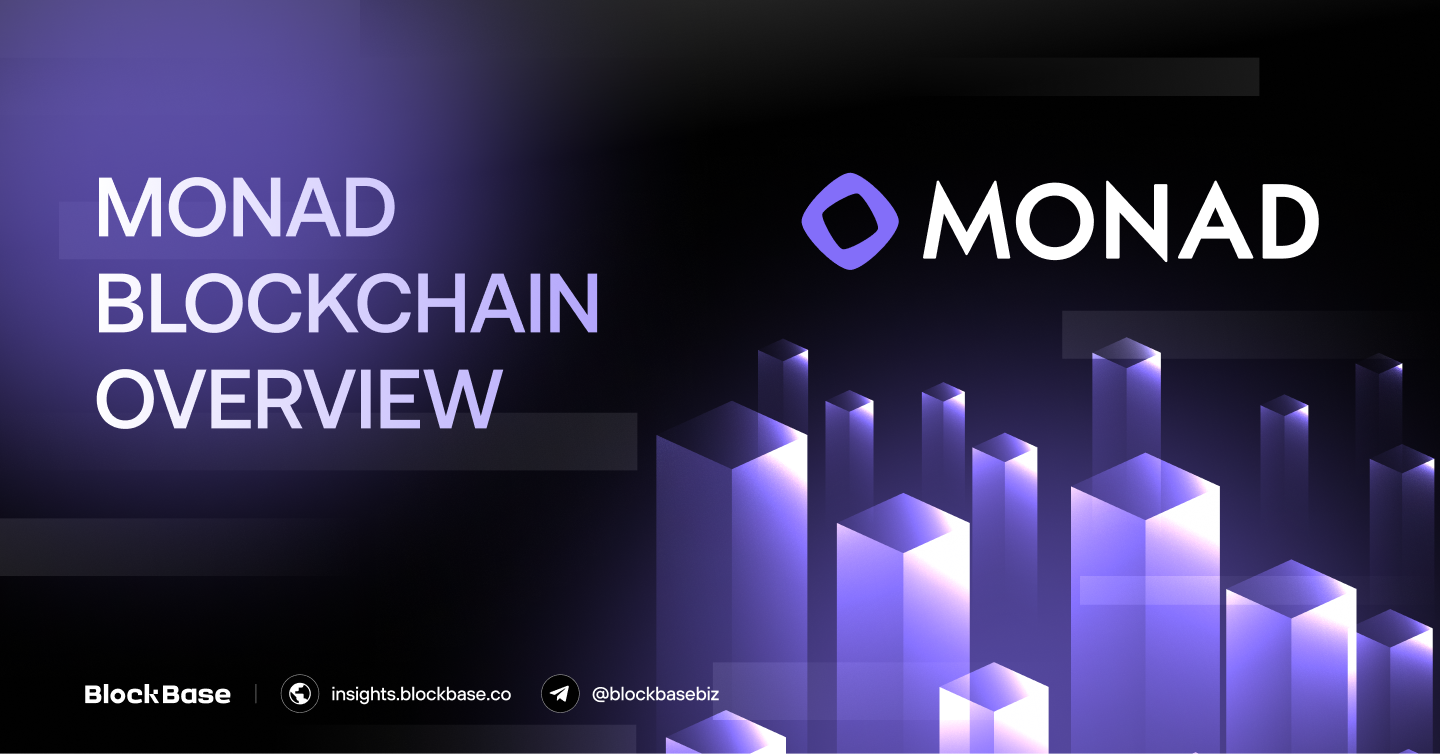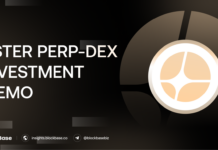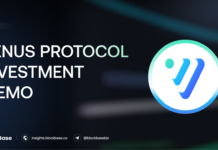Key Takeaways
- Optimized EVM Compatibility: Monad aims to enhance Ethereum’s performance by optimizing the Ethereum Virtual Machine (EVM) for higher scalability and speed, achieving up to 10,000 transactions per second.
- Innovative Technology: Monad introduces several technological advancements including MonadBFT for consensus, Deferred Execution to separate transaction execution from consensus, Parallel Execution for simultaneous transaction processing, and MonadDb for improved database management with async I/O.
- Strong Community and Ecosystem Support: Monad has garnered significant attention and investment, raising $244 million in funding from prominent investors. It supports a wide range of projects and applications across various sectors like DeFi, NFTs, and gaming, and emphasizes a strong, engaged community.

1. Introduction to Monad blockchain
Monad isn’t just another blockchain; it’s an ambitious project aiming to fundamentally optimize the Ethereum Virtual Machine (EVM). Launched with a vision to scale decentralization, Monad seeks to bridge the gap between high performance and EVM compatibility. Monad materially advances the efficient frontier in the tradeoff between decentralization and scalability. In short, it’s the new blockchain with Ethereum power with the transaction ability of Solana.
2. Founders and Background
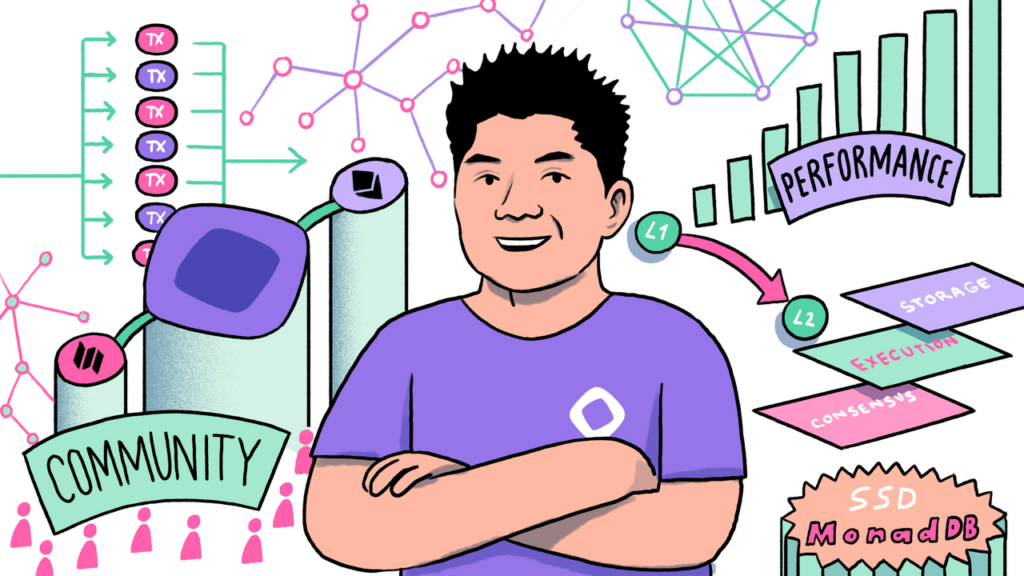
Monad is the brainchild of Keone Hon, James Hunsaker, and Eunice Giarta (CEO, CTO, and COO respectively).
Both Keone Hon and James Hunsaker left longtime technical roles at Jump Trading/Jump Crypto to focus on building their ‘Ethereum killer’ blockchain, Monad. Eunice Garta operated as a product manager in the trad tech world before aligning with crypto.
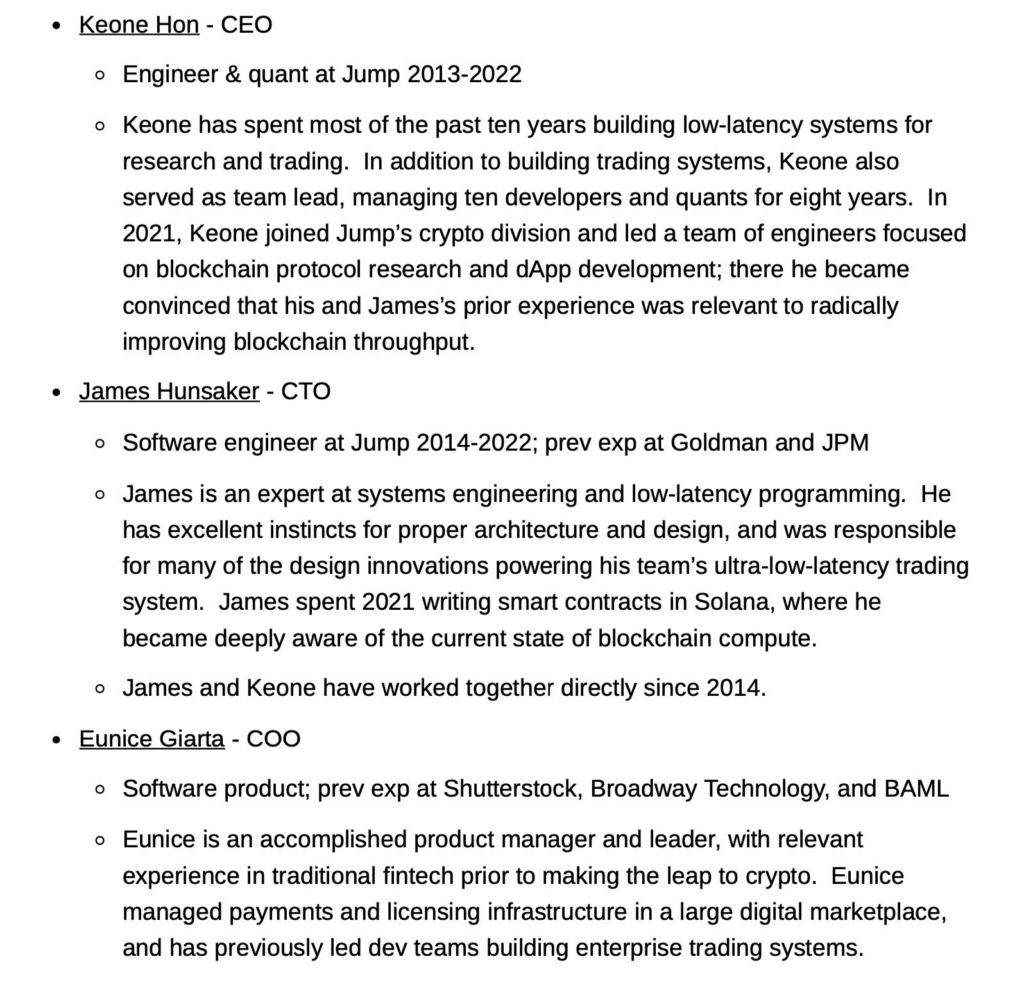
3. How does Monad work?
Monad operates similarly to Ethereum and users will interact with the new blockchain using established Ethereum wallets, explorers, etc. Once Monad is live, developers will be able to port existing Ethereum apps to Monad and users will be able to interact with those dApps.
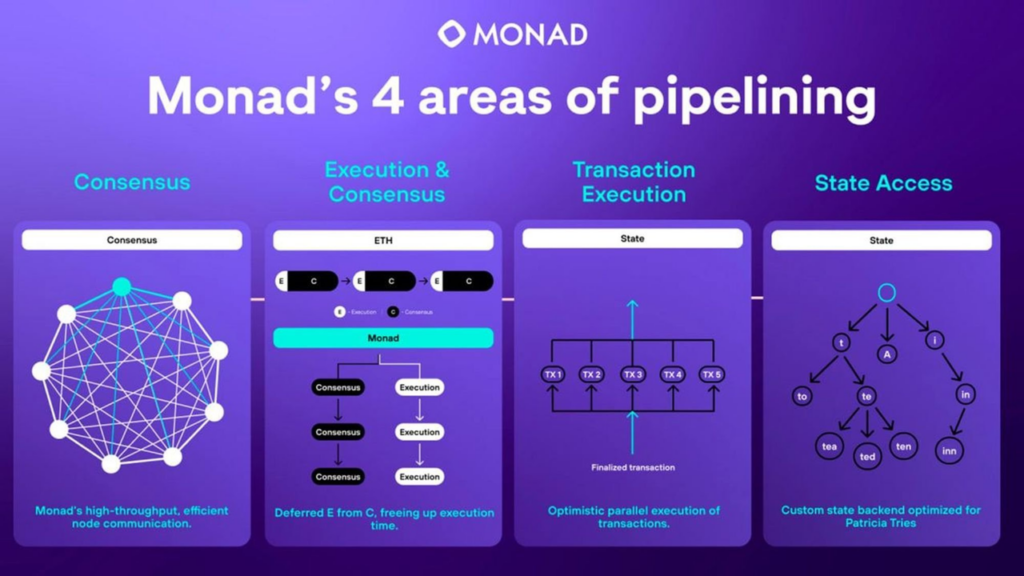
Monad introduces optimizations in four major areas, resulting in a blockchain with a throughput of 10,000 transactions per second (tps):
3.1. MonadBFT
Every blockchain needs a consensus mechanism that ensures the integrity of the blockchain by validating transactions and synchronizing validator nodes.
In the case of Monad, a high-performance consensus mechanism for achieving agreement about transaction ordering under partially synchronous conditions in the presence of Byzantine actors (pipelined two-phase HotStuff consensus). This means that the Monad consensus mechanism quickly verifies transactions even if it detects faulty or malicious validator nodes.
Readers can find explanations about HotStuff and Byzantine consensus via this useful blog: https://medium.com/@Elifhilalumucu/understanding-hotstuff-and-byzantine-fault-tolerance-393ca878173f
3.2. Deferred Execution
Execution decoupled from consensus. In the Monad consensus, nodes come to an agreement about the official ordering of transactions but without either the leader or validating nodes having to have executed those transactions yet.
The Monad BFT consensus mechanism operates differently than established blockchain practices by “decoupling” the execution from consensus.
With Monad, nodes reach an agreement about transactions without a validating node executing the transaction. Monad removes the requirement that nodes execute before consensus.
3.3. Parallel Execution

Transactions are usually executed simultaneously. Parallelization allows tasks to be performed simultaneously, reducing processing time and increasing efficiency. It used to process multiple transactions simultaneously while maintaining a linearly ordered set of transactions, just like ETH. As parallelism concept was also provided by $SEI. But it radically solves other problems and is grateful for this multiprocessing. We can don’t lose too much money on gas. $SOL also utilizes parallel execution but requires its own virtual machine and programming language. Here is a snapshot of a KOL shilling Monad over Solana.

In conclusion, Monad is EVM compatible, allowing easy deployment of your favorite apps like Uniswap, AAVE, or Curve, but includes the benefit of high transactions per second, like Solana.
3.4. MonadDb
- Custom database for blockchain state
- Fully utilizes the latest kernel support for async I/O
When one transaction needs to read state from disk, one should not block waiting for that operation to complete – instead one should initiate the read and then start working on another transaction in the meantime.
Therefore the problem needs asynchronous i/o (async i/o) for the database. The above-mentioned key-value databases lack proper async i/o support (although there are some efforts to improve in this area).
MonadDb fully utilizes the latest kernel support for async i/o (on Linux this is io_uring). This avoids needing to spawn a large number of kernel threads to handle pending i/o requests in an attempt to perform work asynchronously.
Here is a graph of the Transaction Lifecycle in Monad for reference to how all of these technical layers work.

4. Project builder perspective: Why should one care about Monad advancements?
Monad’s improvements address existing bottlenecks while preserving seamless compatibility for application developers (full EVM bytecode compatibility) and users (Ethereum RPC API compatibility). As a result, the rich landscape of Ethereum tooling and applied cryptography research can plug seamlessly into Monad while benefiting from improved throughput and scale:
- applications (any dApps built for Ethereum)
- developer tooling (e.g. Foundry, Hardhat, Apeworx)
- wallets (e.g. Phantom, MetaMask)
- analytics/indexing (e.g. Etherscan, Dune)
However, decentralized apps need cheap, performant infrastructure to reach their intended level of impact. A single app with 1 million daily active users (DAUs) and 10 transactions per user per day would require 10 million transactions per day or 100 tps. A quick glance at L2Beat – a useful website summarizing the throughput and decentralization of existing EVM-compatible L1s and L2s – shows that no EVM blockchain supports even close to that level of throughput right now.
Monad materially improves the performance of an EVM-compatible blockchain network, pioneering several innovations that will hopefully become standard in Ethereum in the years to come. With Monad, developers, users, and researchers can reuse the wealth of existing applications, libraries, and applied cryptography research that has all been built for the EVM.
4.1. Normal user perspective: What’s familiar with Monad?
From a user perspective, Monad behaves very similarly to Ethereum. You can use the same wallets (e.g. Phantom or MetaMask) or block explorers (e.g. Etherscan) to sign or view transactions. The same apps built for Ethereum can be ported to Monad without code changes, so it is expected that you’ll be able to use many of your favorite apps from Ethereum on Monad. The address space in Monad is the same as in Ethereum, so you can reuse your existing keys.
Like Ethereum, Monad features linear blocks and linear ordering of transactions within a block. Like Ethereum, Monad is a proof-of-stake network maintained by a decentralized set of validators. Anyone can run a node to independently verify transaction execution, and significant care has been taken to keep hardware requirements minimal.
4.2. Normal user perspective: What’s different about Monad?
Monad makes exceptional performance possible by introducing parallel execution and superscalar pipelining to the Ethereum Virtual Machine.
Parallel execution is the practice of utilizing multiple cores and threads to strategically execute work in parallel while still committing the results in the original order. Although transactions are executed in parallel “under the hood”, from the user and developer perspective, they are executed serially; the result of a series of transactions is always the same as if the transactions had been executed one after another.
Superscalar pipelining is the practice of creating stages of work and executing the stages in parallel. A simple diagram tells the story:

A familiar example of pipelining: doing laundry intelligently. Top: naive; bottom: pipelined. Credit: Prof. Lois Hawkes, FSU
When doing four loads of laundry, the naive strategy is to wash, dry, fold, and store the first load of laundry before starting on the second one. The pipelined strategy is to start washing load 2 when load 1 goes into the dryer. Pipelining gets work done more efficiently by utilizing multiple resources simultaneously.
5. Funding and Ecosystem Development
Monad raised $19M initially, followed by a massive $225M round led by Paradigm, showcasing strong investor confidence in its tech and vision.
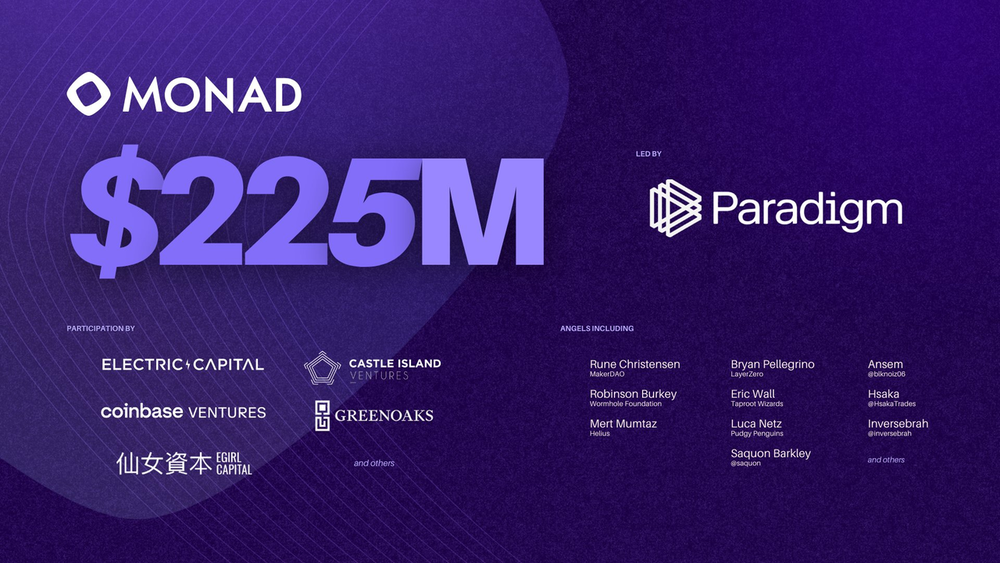
Currently, in testnet phase, some major projects in certain categories are:
- Bridges: @axelar, @decentxyz, @LayerZero_Labs, @wormhole
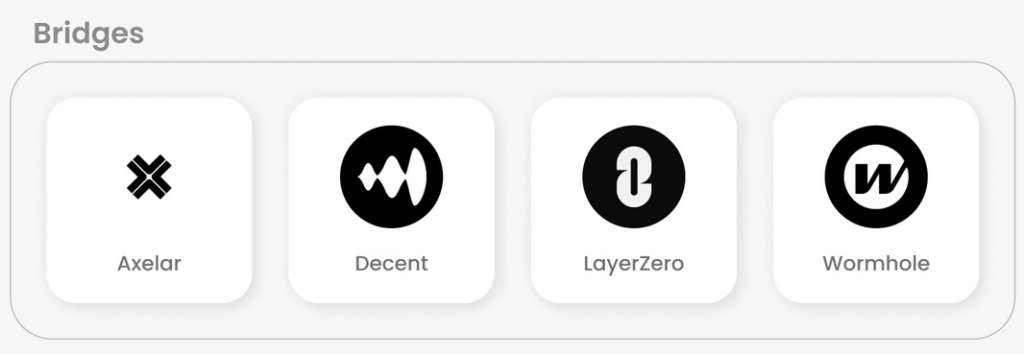
- Lending & Borrowing: @PikeFinance, @Curvance, @TimeswapLabs

- Wallet/Payment: @MetaMask, @Rabby_io, @sphere_labs

- DeFi & DEX: @ambient_finance, @Balancer, @DysonFinance, @NitroFinance, @pear_protocol, @ShrimpDEX, @tayaswap, @WombatExchange, @KuruExchange.

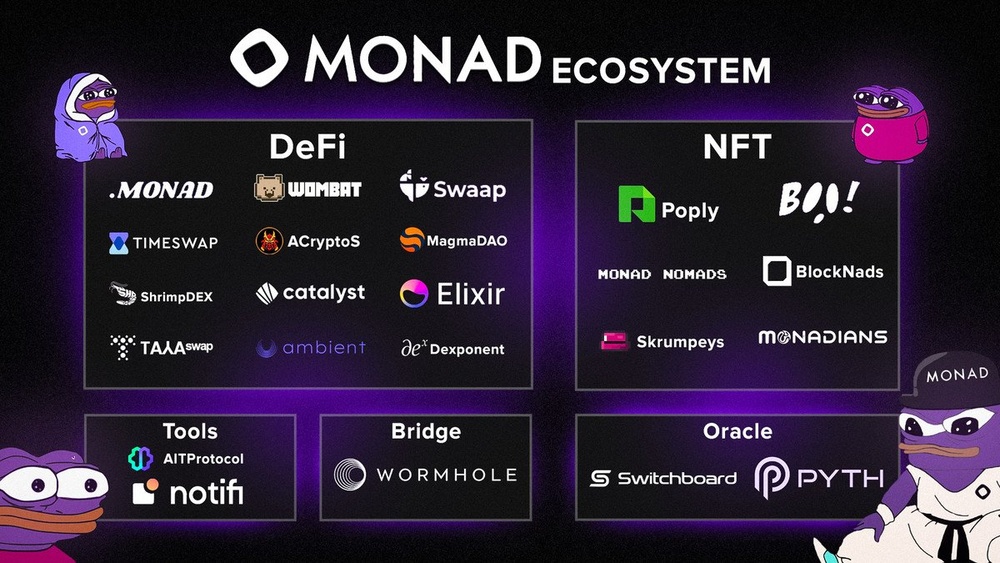
6. Strong community and Culture
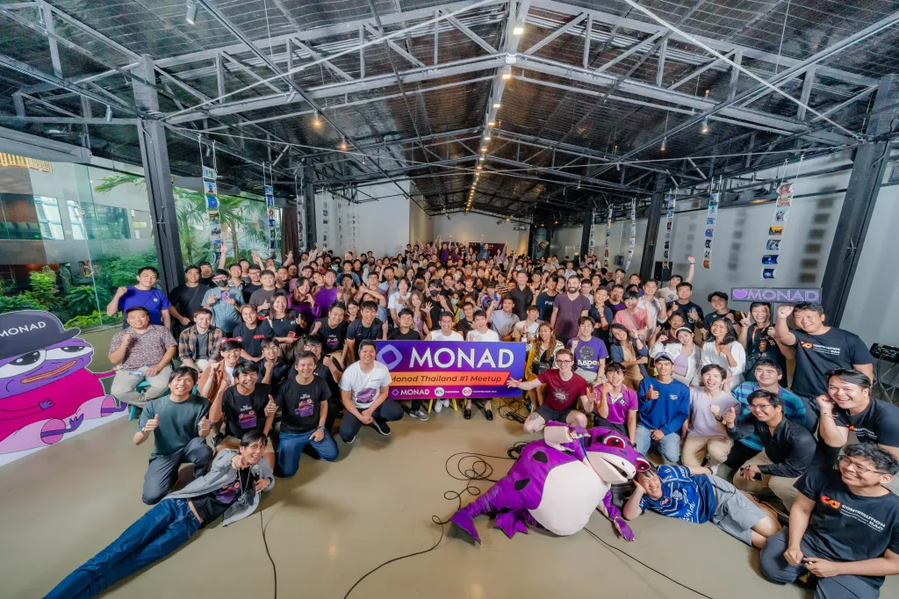

Monad isn’t just about tech; it’s about community. From its inception, there’s been a focus on building a supportive, engaged community, evident from the cult-like following and creative expressions like “Molandak” and mixtapes.
7. Conclusion
Monad represents a significant evolution in blockchain technology, focusing on performance without sacrificing the benefits of EVM compatibility. Its journey from concept to one of the most anticipated launches in crypto shows a blend of technological innovation and community engagement.
With testnet launches in 2024 and mainnet expected soon after, Monad positions itself not just as a competitor but as a potential leader in blockchain scalability, aiming to redefine what’s possible in decentralized systems.
The information provided in this article is for reference only and should not be taken as investment advice. All investment decisions should be based on thorough research and personal evaluation.


